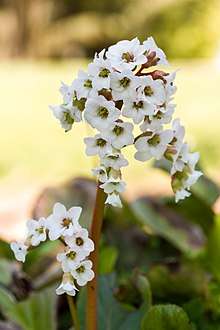Bergenia
Bergenia /bərˈɡɛniə/[1] (elephant-eared saxifrage, elephant's ears) is a genus of ten species of flowering plants in the family Saxifragaceae, native to central Asia, from Afghanistan to China and the Himalayan region.
| Bergenia | |
|---|---|
.jpg) | |
| Bergenia cordifolia | |
| Scientific classification | |
| Kingdom: | Plantae |
| Clade: | Tracheophytes |
| Clade: | Angiosperms |
| Clade: | Eudicots |
| Order: | Saxifragales |
| Family: | Saxifragaceae |
| Genus: | Bergenia Moench |
| Species | |
|
See text | |
Description
They are clump-forming, rhizomatous, evergreen perennials with a spirally arranged rosette of leaves 6–35 cm long and 4–15 cm broad, and pink flowers produced in a cyme.[2] The leaves are large, leathery, ovate or cordate, and often have wavy or saw-toothed edges. For most of the year, the leaves have a glossy green colour, but in cooler climates, they turn red or bronze in the fall. The flowers grow on a stem similar in colour to a rhubarb stalk and most varieties have cone-shaped flowers in varying shades of pink. These can range from almost white to ruby red and purple.[3]
The common names for Bergenia are pigsqueak (due to the sound produced when two leaves are rubbed together), elephant's ears (due to the shape of the leaves) and large rockfoil.
Bergenia is closely related to Mukdenia, Oresitrophe, Astilboides and Rodgersia.
The creator of the taxonomic genus name, Conrad Moench, honoured the German botanist and physician Karl August von Bergen by coining the name Bergenia in 1794.
Species
- Bergenia ciliata, including the cultivar Bergenia ciliata 'Superba'
- Bergenia crassifolia (syn. Bergenia cordifolia) is the most widely grown garden plant, especially the cultivar Bergenia cordifolia 'Purpurea.' The species epithet crassifolia means thick-leaved, and cordifolia means cordate (heart-shaped) leaf (although the leaves may also be described as spoon-shaped). It grows to about 30 cm tall. The leaves are winter hardy and change color in the range of rust brown to brown-red. Other cultivars are Bergenia cordifolia 'Winterglut', Bergenia cordifolia 'Senior', and Bergenia crassifolia 'Autumn Red'.
- Bergenia emeiensis
- Bergenia ligulata
- Bergenia pacumbis
- Bergenia purpurascens is 30 - 40 cm tall and has carmine-red flowers. The leaves are oval-shaped.
- Bergenia purpurascens var. delavayi is ca. 50 cm tall with small leaves and rosy red flowers.
- Bergenia scopulosa
- Bergenia stracheyi with the cultivars Bergenia stracheyi 'Alba' and Bergenia stracheyi 'Afghanica'
- Bergenia tianquanensis
Cultivation
Bergenia are hardy plants that can grow in climates with extreme temperature ranges from about −35 °F (−37 °C) to 115 °F (46 °C). They prefer sun but will grow in shady areas as well. Plants can grow to about 24 in (61 cm) tall and 24 in (61 cm) wide. They do well in most soils, but moist, humus-rich soil is preferable. Exposure and dry soils tend to stunt growth, but can enhance the winter leaf colours. In areas with cold, strong winter winds, protection from the wind may be required.[3] They are propagated by division or rooted rhizome sections.[2]

Bergenia crassifolia, Bergenia cordifolia, and various hybrids are often grown in gardens, with several cultivars selected.
The following cultivars have gained the Royal Horticultural Society's Award of Garden Merit:-
- B. cordifolia 'Rosa Zeiten'[4]
- B. purpurascens[5]
- B. purpurascens var. delavayi[6]
- 'Biedermeier'[7]
- 'Bressingham White'[8]
- 'Britten'[9]
- 'Claire Maxine'[10]
- 'Eden's Magic Giant'[11]
- 'Eric Smith'[12]
- 'Eroica'[13]
- 'Frau Holle' [14] (pale pink)
- 'Sunningdale'[15]
- 'Irish Crimson'[16]
- 'Morgenröte'[17]
- 'Pugsley's Pink'[18]
- 'Silberlicht'[19]
- 'Wintermärchen'[20]
Pests and diseases
Bergenia are robust plants and generally free of problems, although vine weevil adults readily eat the edges of the leaves, resulting in an indented, 'notched' outline which can detract from the appearance of the plant.
Uses
Bergenin, C-glycoside of 4-O-methyl gallic acid, and its O-demethylated derivative norbergenin, are chemical compounds and drugs of Ayurveda, commonly known as Paashaanbhed. They can be isolated from Bergenia ciliata and Bergenia ligulata[21] and from rhizomes of Bergenia stracheyi. It shows a potent immunomodulatory effect.[22]
References
- Sunset Western Garden Book, 1995:606–607
- RHS A-Z encyclopedia of garden plants. United Kingdom: Dorling Kindersley. 2008. p. 1136. ISBN 978-1405332965.
- "Guide to Growing Bergenia Plants". The Garden Helper. Retrieved 2009-06-30.
- "Bergenia cordifolia 'Rosa Zeiten'". RHS. Retrieved 12 April 2020.
- "Bergenia purpurascens". RHS. Retrieved 12 April 2020.
- "Bergenia purpurascens var. delavayi". RHS. Retrieved 12 April 2020.
- "Bergenia 'Biedermeier'". RHS. Retrieved 12 April 2020.
- "Bergenia 'Bressingham White'". RHS. Retrieved 12 April 2020.
- "Bergenia 'Britten'". RHS. Retrieved 12 April 2020.
- "Bergenia 'Claire Maxine'". www.rhs.org. Royal Horticultural Society. Retrieved 12 April 2020.
- "Bergenia 'Eden's Magic Giant'". RHS. Retrieved 12 April 2020.
- "Bergenia 'Eric Smith'". RHS. Retrieved 12 April 2020.
- "Bergenia 'Eroica'". RHS. Retrieved 12 April 2020.
- "Bergenia 'Frau Holle'". RHS. Retrieved 12 April 2020.
- "Bergenia 'Sunningdale'". RHS. Retrieved 12 April 2020.
- "Bergenia purpurascens 'Irish Crimson'". RHS. Retrieved 12 April 2020.
- "Bergenia 'Morgenröte'". RHS. Retrieved 12 April 2020.
- "Bergenia 'Pugsley's Pink'". RHS. Retrieved 12 April 2020.
- "Bergenia 'Silberlicht'". RHS. Retrieved 12 April 2020.
- "Bergenia 'Wintermärchen'". RHS. Retrieved 12 April 2020.
- Simultaneous quantification of bergenin, catechin, and gallic acid from Bergenia ciliata and Bergenia ligulata by using thin-layer chromatography. Dhalwal K., Shinde V.M., Biradar Y.S. and Mahadik K.R., 2008, INIST:20528090
- Immunomodulatory effect of bergenin and norbergenin against adjuvant-induced arthritis—A flow cytometric study Nighat Nazira, Surrinder Koulb, Mushtaq A. Qurishia, Sachin C. Tanejab, Sheikh F. Ahmadc, Sarang Banic and Ghulam N. Qazi, 2006
External links
| Wikimedia Commons has media related to Bergenia. |